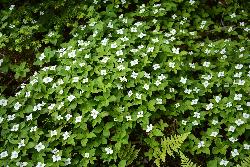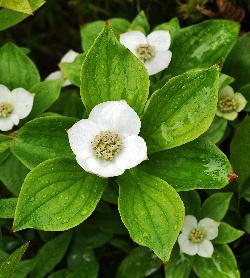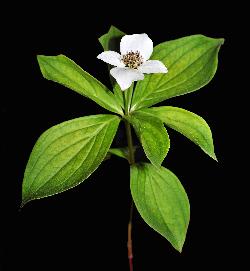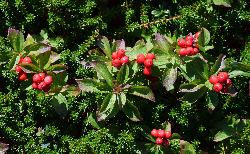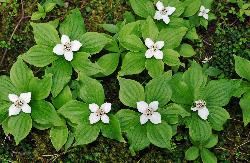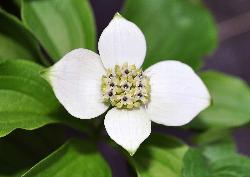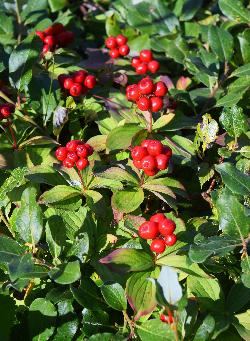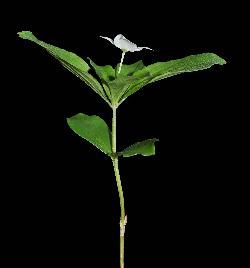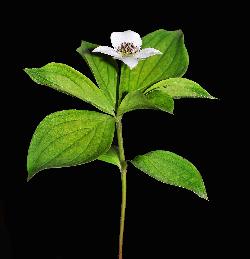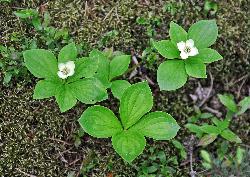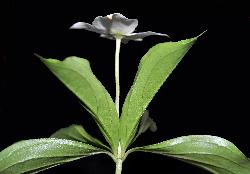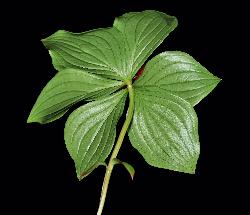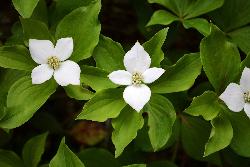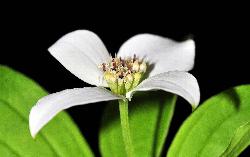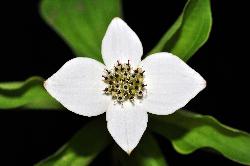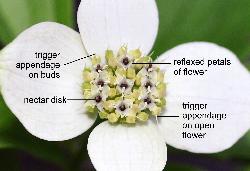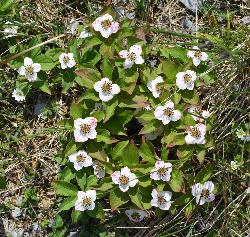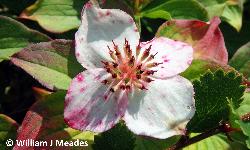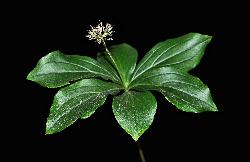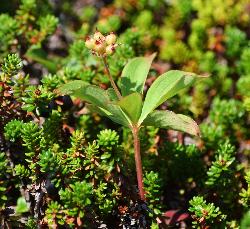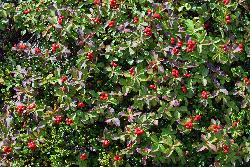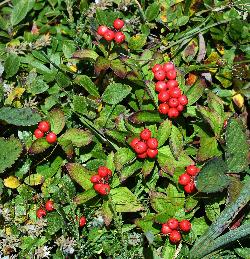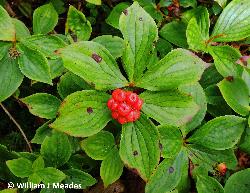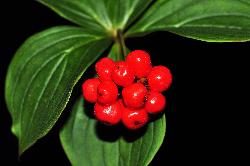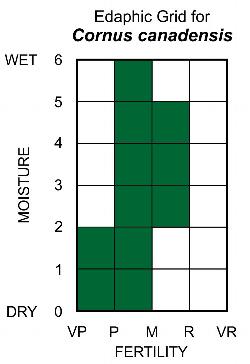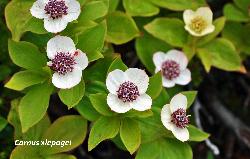Fr: quatre-temps, cornouiller du Canada, rougets
IA: shashakuminanakashi, shashakuminan (the fruit), ode'iminijiibik
IU: sigalak/sigalâk, imukkuluk, kimminaujak (berry)
Cornaceae - Dogwood Family
Note: Numbers given in square brackets in the text refer to the images presented above; image numbers are displayed to the lower left of each image.
General: A low perennial herb, 0.5–2.3 dm tall, spreading by slender woody rhizomes; lateral buds on the rhizomes give rise to erect vegetative and flowering shoots (Hall and Sibley 1976). Bunchberry is a common understorey species of the boreal forest [1–4], often overlooked, perhaps because it is so common; it also occurs frequently on barrens and bog hummocks. Bunchberry is known locally as crackerberry or crackers, due to the 'crack' or 'popping' sound heard when you squeeze the berries between your teeth. It is also one of very few species with explosive pollination as their unique method of pollen dispersal (Jackson 2005). The bunchberry species in our area that exhibit this trait have been included within the genus Chamaepericlymenum (Ascherson and Graebner 1899), but this transfer was based primarily on the herbaceous habit of the plants and the presence of 4 petal-like (petaloid) bracts subtending the inflorescence. Currently, Cornus is the accepted genus for non-woody and woody dogwood species.
Key Features:
- Leaves opposite, elliptic or obovate, with 2 or 3 terminal pairs of leaves that appear as a whorl of 4 or 6 leaves below the inflorescence [5].
- Bunchberry flowers occur in a 'false flower', called a pseudanthium; numerous small white flowers are arranged in a head-like (capitate) inflorescence subtended by 4 white petaloid bracts [6].
- The red-orange to red ovoid or globose fruit (drupes) occur in rounded terminal clusters [7].
Stems: Erect leafy shoots arise from the rhizomes; the herbaceous stems are somewhat angular, slightly pubescent, and bear 2–3 pairs of opposite leaves near the top of the shoot and 1–2 pairs of smaller leaves or bracts farther down the stem [8–9].
Leaves: Sterile shoots have 2 terminal pairs of opposite leaves, separated by a very short internode, thus appear as a whorl of 4 leaves [10]. Fertile shoots are similar, but have 6 leaves that subtend the terminal inflorescence: one pair of larger leaves with a pair of smaller leaves borne in the axil of each larger leaf [11–12]. Leaves are opposite, simple, deciduous, very short-petiolate, and pinnately-veined, with 3–4 pairs of arcuate veins that emerge from along the midrib and curve forward towards the leaf apex [10]. Leaf blades are elliptic to obovate, 2.5–9 cm long by up to 5 cm wide; the blade tapers gradually at both ends to the cuneate base and pointed (acute) apex; margins are entire. The blade surface is dark green above and paler beneath [13]; both surfaces bear short appressed hairs, best viewed with a handlens. In autumn, the leaves turn dark reddish-purple [14].
Flowers: The bunchberry 'flower' is actually a false flower (pseudanthium) formed by numerous small true flowers, each about 2 mm across, arranged in a dense capitate inflorescence (compound cyme) borne on a 1–4 cm long peduncle [12]. The inflorescence is subtended by 4 white ovate petaloid bracts [6, 15], each 0.7–2.5 cm long by 0.5–1.8 cm wide and often tinged with green or pink at the apex. Individual flowers of the cyme are borne on short pedicels, have a small calyx with 4 short triangular lobes, 4 creamy white petals, 4 stamens, and an inferior ovary [16–17]. A dark purple nectar disk surrounds the base of the erect style [17–18]. The outer surface of one or more petals of each flower terminates in a slender bristle-like point that stands erect above the bud [17, 19]. This appendage of the petal is actually a trigger, which when touched by a pollinator, causes the flower to open explosively. At the same time, the anthers dehisce and pollen is forcibly dispersed onto the unsuspecting pollinator (Mosquin 1985, Jackson 2005). While bunchberry is effectively pollinated by insects (entomophily), its method of pollen release is termed explosive pollination, a fairly rare feature amongst flowering plants.
Shortly after pollination, the white bracts often turn pinkish [20–21], due to senescence, then the bracts and flower petals drop off, revealing the short branches of the compound cyme [22]. The prominent nectar disks persist at the top of the developing fruit [23].
Of the Cornus species in our area, only common bunchberry (C. canadensis), the Swedish bunchberry (C. suecica L.), and their hybrid (C. ×lepagei Gervais and Blondeau) exhibit explosive pollination and have petals with trigger appendages. With respect to pollination, all Cornus species are obligate outcrossers and generalists; one study recorded 65 different taxa of insects visiting bunchberry, including flies, bees, beetles, butterflies, and true bugs, with bumblebees (4 Bombus spp.) considered to be major pollinators of Cornus canadensis (Barrett and Helenurm 1987).
Fruit: A cluster of ovoid to globose berry-like drupes, 5–8 mm across. Immature fruits are yellow-green [23], while mature fruits are red-orange to red [24–27]. Each fleshy fruit contains a small stony pit surrounding 2 seeds. The flesh of the fruit is described as flavourless (insipid), but the fruits are not poisonous and are considered edible by many. An average of 12 fruits per cluster have been reported by Hall and Sibley (1979); however, the number of fruits per plant depends upon varying degrees of successful fertilization. Dispersal is by mammals and frugivorous birds (endozoochory) who defecate or regurgitate the seeds after eating the fruit (Gucker 2012).
Ecology and Habitat: Bunchberry occurs throughout the forests of Newfoundland and Labrador, as well as in heathland and peatland habitats. It is ubiquitous in all forest types, usually covering 5–10% of the understorey. Although considered shade-tolerant, it does respond to light and may become more abundant on the forest edge or in gaps created by blowdowns.
Edaphic Grid: See image [28]: the Edaphic Grid for Cornus canadensis.
Forest Types: Bunchberry can be found in all forest types, but is absent from mountain maple thickets and alder swamps.
Succession: Bunchberry can spread by seed and vegetatively through rhizomes following logging, but spreads primarily by rhizomes after fire. Seeds can remain viable in the humus for as long as 3 years. The rate of recovery from disturbance depends on its frequency and intensity. Rhizomes can grow up to 1 m in length per year and, if most of the humus layer is left intact, populations can recover on burns and cutovers in the first 3–5 years. Recovery may take more than a decade if the forest floor is destroyed by disturbance (Gucker 2012).
Distribution: Bunchberry is a circumboreal species that occurs throughout Newfoundland and Labrador, even north of the treeline as far as Okak Bay. It occurs throughout Canada and the northern United States, extending south along mountain ranges (Scoggan 1978).
Similar Species: Swedish bunchberry (Cornus suecica L.) is most similar to bunchberry, sharing its herbaceous habit, presence of 4 white bracts that subtend the flowers, and the same explosive pollination trait. Swedish bunchberry is differentiated by its smaller leaves, 1–3 cm long, which occur in pairs separated by distinct internodes, dark purple flowers, and smaller red drupes, which are about 5 mm in diameter. Image [29] compares a flowering shoot of bunchberry and Swedish bunchberry. Swedish bunchberry occurs on coastal heaths and headlands, but is absent from interior regions of the province. Cornus ×lepagei, a hybrid between C. canadensis and C. suecica, occurs where the range of the parent species overlaps; the hybrid can be recognized by its pale purple, sometimes 2-toned, petals [30], and intermediate size and leaf arrangement.


